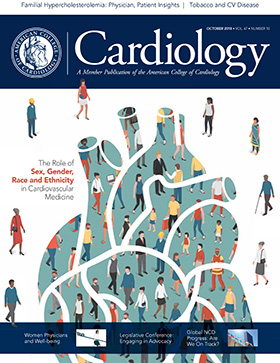Editor's Corner | Improving Care of Our Patients: Insights From ESC Congress 2018

Munich, like most of Europe, was warm but tolerable during ESC Congress 2018. The large convention halls provided a cool respite and ample room for the numerous sessions and exhibits. As in past years, the congress was dominated by important randomized clinical trials.
We've also seen an increase in large data registries, particularly those based on data gathered from federally-funded national databases, that allow us to observe longitudinal data over multiple generations. With statistical techniques such as propensity matching, the data can be used to create clinical trials that allow analyses useful for improving overall health and answering specific questions on patient outcomes across a wide spectrum of clinical observations.
The ROPAC registry, for example, has provided important insights into pregnancy and heart disease that can help to assess increased risk during pregnancy and identify those with reduced risk for serious complications and thus can undergo a successful, complication-free pregnancy.
Clinical analysis from another study of registry data identified increased risk of aortopathy and dissection. Coincidentally, in August we saw an updated version of the ACC/AHA guidelines on management and monitoring for adult congenital heart disease patients. (Visit the Guideline Hub at ACC.org.)
Euro Aspire V, a 21-country registry that tracks long-term cardiovascular risk, provided some encouraging data, with a small improvement in the obesity rate, down to 37 percent vs. 38 percent in Euro Aspire IV. Although the year-to-year risk reduction was small, cumulative long-term improvement in cardiovascular health can become substantial.
ASCOT extended their Legacy study to examine long-term effects on combined cardiovascular outcomes in patients receiving both lipid-lowering therapy and hypertension therapy. In this 16-year study, patients receiving both therapies, vs. those receiving only hypertension therapy, had improved outcomes.
PURE is back again, this time with a substudy of 1,800 participants from Poland. In women, dietary modification had a positive effect on cardiovascular disease outcomes. In men, this effect was not as strong, but a reduction in fat and sugar intake was associated with a significantly lower risk of cardiovascular disease. The PURE registry of 84,000 women and 42,000 men, followed for up to 30 years, continues to show the benefit of dietary modification on cardiovascular risk.
And we come back to aspirin, which does not add a primary prevention benefit in patients with type 2 diabetes. ASCEND showed a small increase in the bleeding rate and a small reduction in cardiovascular events after seven years and the overall outcome was neutral.
COMPASS compared rivaroxaban with combined aspirin plus rivaroxaban on cardiovascular outcomes in more than 16,000 patients. The overall outcome was neutral, but some subgroups showed some advantage with rivaroxaban. Interestingly, genitourinary bleeding may be an early sign of cancer in patients taking rivaroxaban.
Outcomes from MARINER showed no benefit of rivaroxaban in patients recently discharged after an acute medical encounter. Rivaroxaban for 45 days after discharge didn't significantly reduce the risk of venous thromboembolism.
In COMMANDER-HF, no difference in myocardial infarction, stroke or mortality was found in stable heart failure patients after 21 months of treatment with rivaroxaban. The overall trend of the studies comparing a direct-acting oral anticoagulant (DOAC) to aspirin therapy suggests that a DOAC alone might be the best choice for therapy in a variety of treatments that require anticoagulation as part of therapy.
In the world of hemodynamics, a shunt from the left atrium (LA) to the right ventricle would be looked upon as a pathologic shunt, likely to cause hemodynamic deterioration. But what if the left heart pressure was high? In what direction would the flow go, what would happen to right atrial (RA) pressure and would the patient tolerate the abnormal shunt?
The REDUCE LAP-HF study in patients with elevated LA pressure showed that the LA to RA shunt could be tolerated – and furthermore improved hemodynamic function by reducing LA pressure and relieving dyspnea. In patients with preserved ejection fraction in REDUCE LAP-HF, wedge pressure did not increase considerably and cardiac output was maintained up to one year. Longer-term effects of the shunt are yet to be determined.
Closure of a patent foramen ovale (PFO) continues to gain interest, particularly after two clinical trials have shown a significant reduction in subsequent stroke risk in patients with PFO closure. The data presented from the randomized trials and meta-analyses at ESC Congress 2018 support the closure strategy and further define the selection criteria for achieving successful closure. An increase in atrial fibrillation (AFib) was noted in the closure group.
Comparison of one- and two-day rhythm monitoring supports the benefit of longer-term monitoring to detect intermittent AFib after acute ischemic stroke. The data indicate that the incidence of AFib is considerably higher than thought and longer monitoring post stroke should be the rule to eliminate AFib as the cause. Monitoring for four to five days, coupled with automated rhythm detection systems, should be a norm for care of patients with an ischemic stroke.
By now, we've incorporated TAVR into our day-to-day practice and considerably widened its indications to the point that it's considered the therapy of choice for nearly most patients with aortic stenosis. But where are we with transcatheter mitral valve replacement (TMVR)?
The TMVR registry provided outcomes data on 521 patients who received a TMVR for a degenerated bioprosthesis, failed annuloplasty ring or severe mitral annular calcification. The data showed excellent outcomes after treatment, with an 87 percent success rate. Both TAVR and TMVR are clearly the future of valvular therapy for aortic and mitral disease.
Preliminary results from the MitraClip trial presented at ESC Congress 2018 were unclear, but the complete trial results presented at TCT 2018 showed a definite value for Mitraclip treatment in patients with severe mitral regurgitation.
Long-term outcomes will continue to improve through better training and experience along with continuing advances in technology. Improved outcomes following TAVR may benefit from a short treatment with anticoagulation to prevent stent thrombosis. While this is a rare complication, it may be beneficial to perform a CT angiogram to eliminate this late complication.
CABANA suggested that AFib ablation produces better protection from atrial arrhythmias than continued medical therapy. APAF-CRT provided some interest in atrioventricular junction ablation followed by CRT therapy in patients with permanent AFib. This method, while not for everyone with AFib, offers a solution for patients with difficult to control permanent AFib.
The data from these and other studies reported in Munich provide important updates on new therapies and treatment methods and many other observations that can be brought to the bedside to improve clinical care for patients throughout the world.


Alfred A. Bove, MD, PhD, MACC, is professor emeritus of medicine at Temple University School of Medicine in Philadelphia, and a former president of the ACC.
Clinical Topics: Anticoagulation Management, Arrhythmias and Clinical EP, Cardiac Surgery, Congenital Heart Disease and Pediatric Cardiology, Dyslipidemia, Heart Failure and Cardiomyopathies, Invasive Cardiovascular Angiography and Intervention, Noninvasive Imaging, Prevention, Pulmonary Hypertension and Venous Thromboembolism, Valvular Heart Disease, Anticoagulation Management and Atrial Fibrillation, Anticoagulation Management and Venothromboembolism, Atrial Fibrillation/Supraventricular Arrhythmias, Aortic Surgery, Cardiac Surgery and Arrhythmias, Cardiac Surgery and CHD and Pediatrics, Cardiac Surgery and Heart Failure, Cardiac Surgery and VHD, Congenital Heart Disease, CHD and Pediatrics and Arrhythmias, CHD and Pediatrics and Imaging, CHD and Pediatrics and Interventions, CHD and Pediatrics and Prevention, CHD and Pediatrics and Quality Improvement, Lipid Metabolism, Acute Heart Failure, Interventions and Imaging, Interventions and Structural Heart Disease, Interventions and Vascular Medicine, Angiography, Computed Tomography, Nuclear Imaging, Hypertension, Mitral Regurgitation
Keywords: ACC Publications, Cardiology Magazine, Pregnancy, Atrial Fibrillation, Stroke, Aspirin, Foramen Ovale, Patent, Incidence, Venous Thromboembolism, Patient Selection, Mitral Valve Insufficiency, Bioprosthesis, Pulmonary Wedge Pressure, Cardiovascular Diseases, Mitral Valve, Diabetes Mellitus, Type 2, Heart Ventricles, Brain Ischemia, Stroke Volume, Transcatheter Aortic Valve Replacement, Risk Factors, Myocardial Infarction, Hemorrhage, Heart Failure, Anticoagulants, Registries, Aortic Valve Stenosis, Hypertension, Primary Prevention, Obesity, Risk Reduction Behavior, Dyspnea, Heart Atria, Thrombosis, Neoplasms, Angiography, Lipids, Stents, Tomography, X-Ray Computed
< Back to Listings








